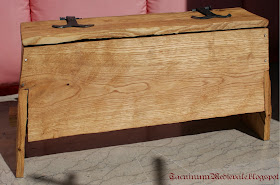 |
| Le cerniere, forgiate a mano Hand-forged hinges |
La sperimentazione però non riguarda solo il legno, ma anche la lavorazione del metallo: anche le cerniere del baule più grande sono state infatti realizzate da lui, usando la forgia - ed era il primo tentativo di costruzione di un pezzo del genere!
Non mi resta che aggiungere che sono davvero orgogliosa dei sui lavori.
(E mi piace soprattutto il bauletto più piccolo, che è per me!)
 |
| Il bauletto più grande: 55x13x30 cm The bigger chest: 55x13x30 cm |
My last posts always start talking about Wisby, and this one is no exception: while I was attending embroidery and sewing workshop, Francesco was following a workshop about woodworking, where he learnt how to make a stool starting from the tree trunk and using only period tools. The stool looks great, but the most important thing is that a seed has been planted, and it startet giving the first results. Francesco actually completed the first two projects, two chests: he made also the ones we have in our tent right now, but he used modern tools, while for these ones he used as much as he could period tools. Both are made wish chestnut wood, assembled with iron nails and treated with linen-seed oil, wich looks great and smells good.
But this isn't only about wood experiments: he made also the hinges for the bigger chest, using a forge - and this was the first time he tryed to make this kind of piece.
I am so proud of his works!
(And I expecially love the little
one-
which is for me!) |
| My little one: 23x16x13 cm |


